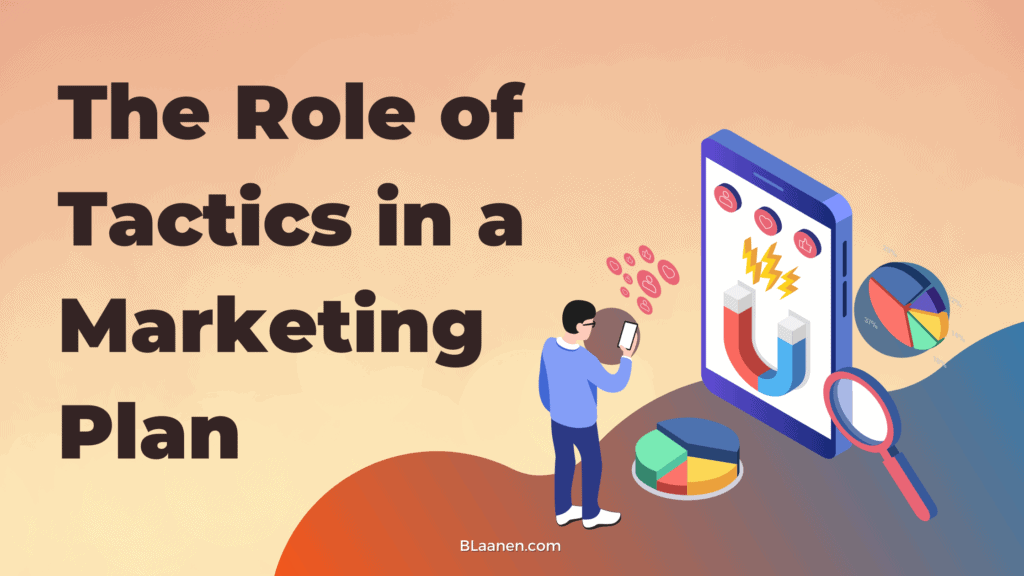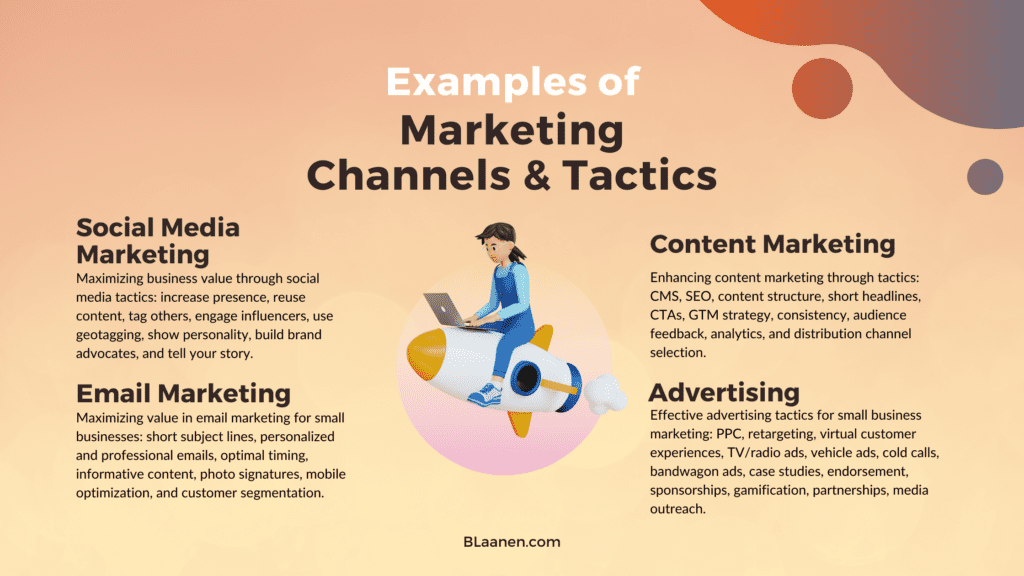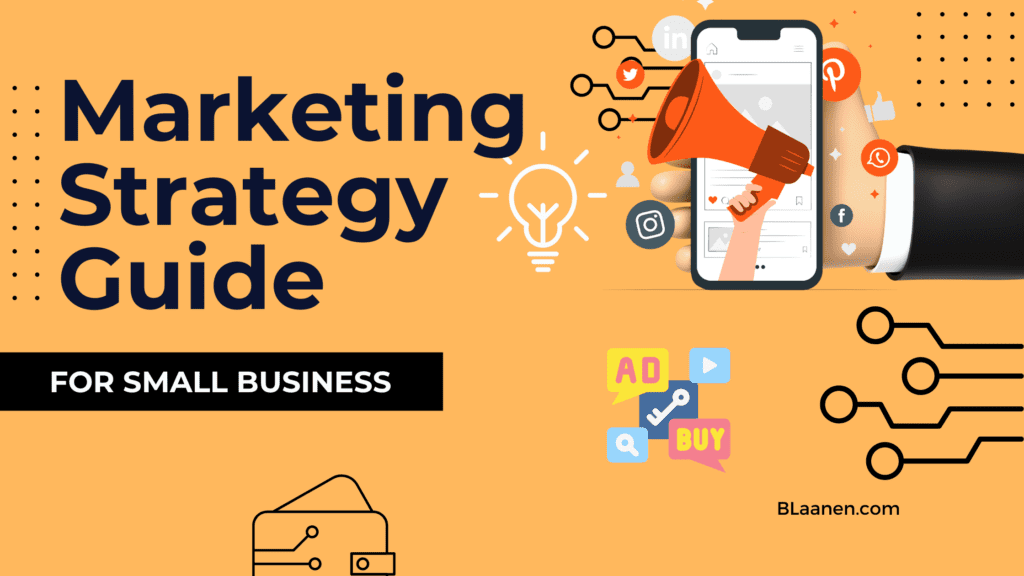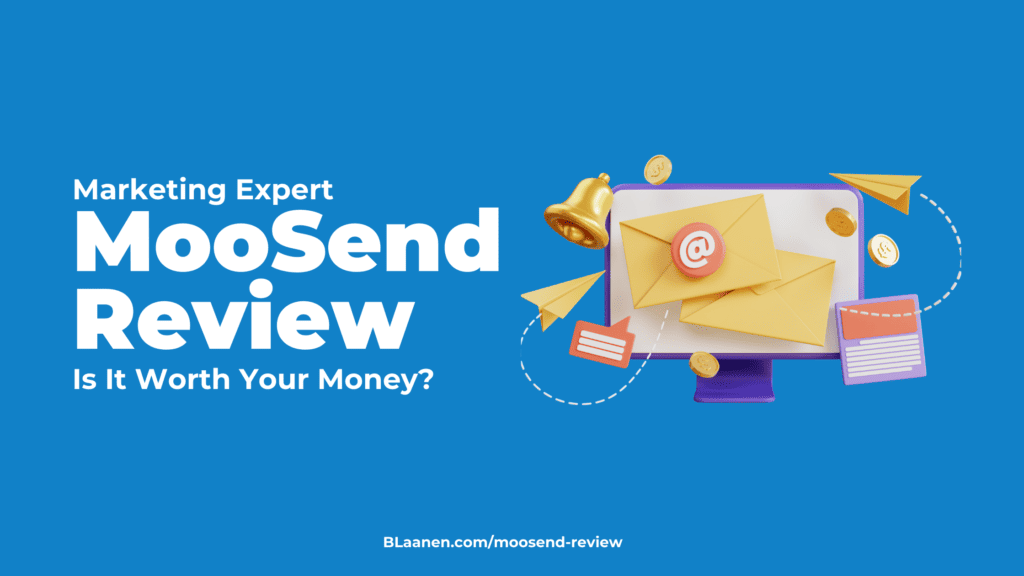In today’s digital age, having a small business marketing plan is essential for any entrepreneur looking to reach their goals.
A marketing plan is the cornerstone of any successful business. It provides structure and guidance on how to market products or services.
A well-crafted marketing plan allows small businesses to focus their limited resources on the most effective strategies. It also helps with targeting the right customers and promoting offerings in an organized manner.
Expert advice can help you plan to market your small business in a way that meets your goals. This can help you save money and grow your business.
This article explores everything you need to know to create a successful marketing plan. This expert advice will help you whether you are launching a start-up or need help with your existing small business marketing efforts.
Table of Contents
Toggle1. How To Make a Marketing Plan for a Small Business
Entrepreneurs can dramatically increase their odds of achieving success by taking the time to:
- Evaluate potential markets.
- Determine product or service positioning.
- Create a unique brand identity.
- Design an advertising campaign that stands out from the competition.
- Measure success consistently.
Steps for Creating a Marketing Plan
Creating a marketing plan is a complex process that requires professionals to take the following steps:
- Initial analysis
- Goal setting
- Researching the target audience
- Defining a marketing budget
- Outlying tactics

1. Initial Analysis
SWOT Analysis
A SWOT analysis can give you an insightful and impartial evaluation of your business. It reveals opportunities to strengthen your performance in various areas.
This strategic planning technique requires you to analyze your business’s:
- Strengths
- Weaknesses
- Opportunities
- Threats
Strengths and weaknesses offer information on internal aspects of your business. Opportunities and threats refer to external elements. This means this analysis allows you to analyze your position compared to your main competitors.
Key Performance Indicators (KPIs)
KPIs measure how successful a company is in different areas. It would help if you used KPIs to analyze your current marketing strategy’s efficiency:
- Social media engagement and reach
- Website traffic
- Leads
- Digital marketing return on investments (ROI)
- Landing page conversion
- Inbound link building
- Email marketing performance
- Mobile conversion rates
- Organic traffic
- Follower growth
- Search rankings
2. Setting Goals
After you have analyzed your situation, it’s essential to establish a list of marketing goals.
Marketing goals differ from business goals, even though many business owners believe they are the same.
A business goal is a desired result that companies strive to achieve. Some examples of such goals are:
- Staying ahead of the competition.
- Increasing profits.
- Continuing to grow.
A marketing goal is an organization’s measurable objective to further its marketing efforts. It reflects the overall success of a company’s campaigns and how effectively they reach their desired customer base.
Some common objectives include:
- Increasing brand awareness
- Improving engagement on social media platforms
- Driving website traffic
- Generating leads
Effective goal-setting should be tailored to your organization’s needs to ensure success. It should also be supported by strategic implementation plans to keep all stakeholders engaged.
Make sure your goals are:
- Realistic
- Time-related
- Measurable
- Achievable
- Specific
3. Researching the Target Audience
Knowing who you are trying to reach with your product or service should be a pillar of your marketing plan. It allows you to focus on the right message and deliver greater accuracy and precision throughout your campaign.
A crucial factor when defining your target audience is that they are the people most likely to want your product or service.
Once you’ve identified your target audience, you can concentrate on delivering a marketing plan.
The marketing plan should communicate the unique benefits of what you have to offer. It allows you to connect emotionally with your target market on a shared level. Doing so boosts brand affinity and encourages more sale leads.
4. Defining the Marketing Budget
A marketing budget is a financial plan. This plan outlines the resources available to an organization for marketing and advertising activities.
It serves as one of the primary instruments for implementing marketing strategies. As a result, it allows businesses to prioritize marketing initiatives. This prioritization is based on their relative importance and value addition.
Having a marketing budget helps businesses control marketing costs. This is achieved by setting limits and goals that balance cost-effectiveness with effectiveness.
For new businesses, it is recommended to spend 12-20% of their gross revenue on marketing. Established companies should plan on spending between 6-12%.
5. Outlining Marketing Tactics
Marketing tactics are strategies to promote and advertise a business, product, or service. There are a variety of tactics that businesses can use depending on their goals and objectives.
With the right combination of tactics, small businesses can optimize their appeal. They can also ensure they continuously offer the best product or service compared to competitors.

Tips for Making the Process Efficient and Effective
- Get ideas from everyone affected by the marketing plan. This includes people from different parts of the company. Also, anyone from outside the company who might be affected by the marketing strategy is essential.
- Make sure that everyone agrees on the goals and how to measure if they are met. This way, everyone will be working towards the same thing.
- Create milestones for each step of the process. This allows you to track your goals and easily adjust along the way.
- Identify any potential challenges or roadblocks that could prevent success early on. This way, you can address them immediately and prevent future issues.
- Ensure that realistic timelines are in place. This ensures that tasks are completed within their allotted time frame, and no steps get dropped due to time constraints.
- Use software tools like project management systems or customer relationship management programs to increase efficiency. These tools streamline workflow processes and automate tasks for efficiency. They save time and money spent on labor costs.
- Involve multiple decision-makers at crucial points throughout the process. Different perspectives on each plan element can lead to a more robust solution overall.
- Make sure to review each step thoroughly before moving forward. This allows you to identify any mistakes or gaps before they become more significant issues down the line.
2. Marketing Strategy
The Role of a Marketing Strategy in a Marketing Plan
A successful small business marketing plan is only useful with an effective marketing strategy to guide it.
An effective marketing strategy provides the framework for all marketing efforts. It lays out goals, objectives, and measurable results that can be tracked.
It also serves as an effective way to keep all teams involved in a successful marketing strategy aligned and up-to-date.
When working with a comprehensive marketing strategy, every team is on the same page, which allows companies to:
- Effortlessly evaluate their successes.
- Optimize performance.
- Make adjustments accordingly.
With a suitable marketing strategy, businesses can take full advantage of their opportunities.
Elements of a Marketing Strategy
Business owners need to rely on a successful marketing plan that includes:
- Segmentation
- Targeting
- Positioning
- Unique value proposal
- Messaging
- Branding

An effective small business marketing strategy uses the segmentation-targeting-positioning model (STP). This model allows small business owners to direct their products or services where they benefit most.
Not all products and services are the same, so it’s a fallacy to think everyone can be your customer. Even though you think selling to everybody will get you the largest income, this is unrealistic.
To determine what target audience will help you achieve the highest success, you should consider:
1. Segmentation
Segmentation is the process of dividing the population into smaller groups (segments) based on different criteria:
- Who are your potential customers? (demographic segmentation) (age, income, gender, etc.).
- Where do they live? (geographic segmentation) (country, region, urban or rural, etc.).
- Why do they purchase your service or product? (Psychological segmentation)(habits, lifestyle, activities, attitudes, etc.)
- How do they use your product? (behavioral segmentation) (usage rates and patterns, interaction, payments, etc.)
2. Targeting
Targeting is the process that helps you determine which segment of the population is most likely to acquire your services or products.
This process requires you to identify which segment brings the most profit in the short and long run.
You can determine which segment you should target by analyzing three factors:
- Profitability
- Ease of reach
- Expanding potential
3. Positioning
Positioning is the process that helps you decide how you are different from your competitors. It also allows you to identify how your service or product is unique. As a result, you will be able to emphasize these qualities and find the people that need you.
Positioning is essential to a marketing plan because it allows you to sell where you need to maximize your profit.
If your product or service is similar to the ones of competitors, you should create features that position it differently from competitors. This is called the unique position.
After determining your position, a good practice is to create a map that allows you to identify where there are gaps in the market that you could fill. This is called a market positioning map.
4. Unique Value Proposition (UVP)
After you have determined your unique position, you should generate a phrase that explains to your customers why you are different from the rest. It should also include info on why they should acquire your services or buy your products.
5. Branding
Developing a branding strategy can be difficult if you don’t understand its elements. What is more complicated is where to put these elements and how to develop processes that maximize your success.
Most people struggle with differentiating between marketing and branding.
A brand is a feature that differentiates your business services or products from those of other companies. This can be a:
- Name
- Symbol
- Design
- Term
- Any other feature
Branding means taking the brand and intentionally modeling, designing, building, and managing its experience and meaning.
Branding essentially allows you, as a small business owner, to create the image you want people to have about:
- The company
- The products
- The services
- Anything related to your business
The essential thing is to keep in mind what your company’s identity is.
Branding strategy is complex, so it’s understandable if you don’t fully understand it yet. Here are the components of a brand strategy that you need to know of to be able to construct an efficient marketing plan:
- Core brand values
- Brand messaging
- Brand personality
- Brand icons
6. Key Messaging
A key message describes the value of your service or product while delivering the information you want your audience to remember. It is usually accompanied by a call to action.
Key messages are important units of any marketing plan. They help build the communication pillars between you and your customers. They help build their perception of your company, products, and services.
Key messages help small businesses deliver:
- Accurate
- Compelling
- Consistent
Information that resonates with their audience.

Tips for Developing a Compelling Marketing Strategy
Use these tips to deliver a compelling marketing strategy:
- Try to understand what strategies have been used and how they were successful or unsuccessful.
- Gather data on industry trends, consumer behavior, competitors, and other relevant topics.
- Take advantage of multiple platforms when promoting your product or service.
- Don’t be afraid to try out different ideas for marketing campaigns. Experimentation often leads to unexpected insights about what messages resonate best with customers.
- Track performance metrics to gauge the ROI from each campaign. This helps you understand which channels are working best for engaging customers.
- As trends change, make sure you adjust accordingly. Even small adjustments can have significant impacts on overall performance.
- Calibrate regularly to ensure all efforts add value vs. costing money without adding tangible benefit.
3. Marketing Tactics and Action Plan
The Role of Tactics in a Marketing Plan
A marketing plan acts as a roadmap for distribution channels, target market strategies, and lead generation activities. It lays out a clear action plan to ensure the company meets its goals and objectives.
A well-developed marketing plan helps an organization:
- Attract qualified prospects.
- Communicate effectively with customers.
- Build relationships with industry peers.
A marketing plan helps deliver insights needed to make decisions within a given timeframe. The market data guides decisions regarding:
- Distribution channels
- Product messaging
- Pricing structure
Focusing on the right metrics and developing a robust plan are integral to reaching the target market.

The Role of Tactics in a Marketing Plan
A marketing plan acts as a roadmap for distribution channels, target market strategies, and lead generation activities. It lays out a clear action plan to ensure the company meets its goals and objectives.
A well-developed marketing plan helps an organization:
- Attract qualified prospects.
- Communicate effectively with customers.
- Build relationships with industry peers.
A marketing plan helps deliver insights needed to make decisions within a given timeframe. The market data guides decisions regarding:
- Distribution channels
- Product messaging
- Pricing structure
Focusing on the right metrics and developing a robust plan are integral to reaching the target market.
Examples of Marketing Tactics
Examples of digital marketing tactics include leveraging search engines, using social media platforms, and developing an engaging website. Traditional marketing channels may still be used in certain circumstances.
Companies must employ various tactics that work best for their goals. They also need to maintain a solid online presence. This builds a thriving base of customers and creates a powerful brand.

1. Social Media Marketing
Here is a list of tactics used in social media marketing that can add value to your business:
- Increase your presence on social media channels.
- Find ways to reuse your content to save time and resources.
- Tag others in posts on social media networks to bring more exposure to your posts.
- Engage smaller influencers in your campaign, as new research says people trust small influencers more.[1]
- Build a local follower group by using geotagging.
- Reveal the personality behind your brand (or build one).
- Build a group of people who boost your brand’s image using word-of-mouth marketing (aka brand advocates).
- Learn how to tell your story on social media channels.
2. Email Marketing
Here is a list of tactics used in email marketing that small business owners can use to provide value:
- Don’t overdo it when it comes to subject lines. Keep your subject lines between 6 and 10 words short to get your customer’s attention.
- Make your emails personal, but keep them professional. Research from 2018[2] states that 80% of your clients are more likely to purchase if they receive personalized emails.[3]
- Make sure you send emails at the right time.
- Use email to inform customers rather than to force them to purchase your services.
- Increase your chances of getting a reply by using a photo signature.[4]
- Optimize your emails for mobile.[5]
- Use customer segmentation to increase your chances of success. Do this based on age[6], or other common characteristics to make emails more engaging.
3. Content Marketing
Content marketing refers to various formats:
- Written content (e.g., blog posts, white papers, press releases)
- Visual content (e.g. videos)
- Audio content (e.g., podcasts)
Here are some tactics used in content marketing you can incorporate into your marketing plan:
- Use a content management system (CMS).
- Optimize content for search engines to boost your ranking (SEO).
- Optimize the structure of your content.
- Make headlines short and engaging.
- Add call-to-action (CTA) sections.
- Implement a go-to-market strategy (GTM).
- Be consistent. Adapt the editorial calendar to your target audience.
- Select the best distribution channel for different content types.
- Observ audience feedback (comments, likes, shares).
- Employ analytic tools.
4. Advertising
Advertising tactics are actions sustained in a strategic manner that creates awareness. They also build relationships with the customers. Business owners use them to promote their services and products.
Here is a list of advertising tactics for a small business marketing plan:
- Pay-per-click (PPC)
- Retargeting
- Virtual customer experiences
- Television and radio ads
- Vehicle ads
- Cold calls
- Bandwagon ads
- Case studies
- Endorsement
- Sponsorships
- Gamification
- Partnerships
- Media outreach
Tips for Choosing the Right Marketing Tactics for a Small Business
If you want to make use of your time and choose the appropriate tactics for your marketing plan, make sure to:
- Evaluate different options that you can use to spread awareness and attract new customers or target audiences.
- Determine which channels have been most successful in reaching your target audience and driving conversions.
- Keep in mind the goals you want to achieve.
- Test the ideas. You can start with smaller campaigns launched through multiple channels. This allows you to see how they work before investing heavily into one strategy over another.
- Evaluate the results using KPIs. Review reports regularly and compare them against industry standards.
- Analyze where you have the highest results.
- Introduce new products or services where you have the highest ROI
- Analyze the new customers’ needs.
The Importance of an Action Plan and How To Create One
Action plans are essential for successful businesses. They provide clarity, direction, and guidance for employees and management alike.
An effective action plan keeps everyone on track and helps ensure that goals are met promptly.
Step 1: Define the desired overall outcome and break it down into specific smaller objectives.
Step 2: Rank the ideas based on their value to the organization and feasibility of implementation.
Step 3: Establish timelines for each task to monitor progress over time.
Step 4: Identify the resources needed to carry out each task. This includes people, equipment, materials, and financial resources.,
Step 5: Create a timeline once all tasks have been identified and assigned. This ensures the completion of each step to properly monitor progress over time.
Step 6: Have regular assessments throughout the life cycle of the project. It helps gauge progress and make necessary adjustments as needed.
The timeline should include:
- Short-term goals (i.e., monthly or quarterly milestones)
- Long-term goals (i.e., annual or multi-year objectives)

4. Marketing Team and Resources
The Role of the Marketing Team in Implementing a Marketing Plan
The success of a small business depends on effectively utilizing its resources. It also depends on your ability to ensure that the right people are in place to implement the plan.
The marketing team should be composed of individuals with experience in various aspects of marketing, including research, planning, Analysis, execution, and measurement.
Tips for Building and Managing a Small Business Marketing Team
Here are some tips for building and managing a small business marketing team:
- Define precisely what you need from your marketing team, including roles, skills, experience, resources, and timeline for completing goals.
- Create an organizational chart that includes job titles, such as social media manager or content writer, and their associated duties.
- Make sure everyone understands how their efforts contribute towards larger goals. This way, they stay motivated throughout the process.
- Consider personality types to create positive team dynamics.
- Develop strategies together to include each level of expertise.
Resources for Small Businesses Looking For Marketing Assistance
Business owners who need assistance creating a marketing plan can access the services of:
- Marketing consultants
- Marketing agencies

Hiring a marketing consultant or agency
Hiring might be the solution to your marketing issues. It’ll allow you to put your best into the business knowing that you’ll have a solid marketing plan that is built by experts to back you up.
The right marketing coach can act as a coach or consultant or totally manage your business’s SEO and marketing aspects.
Marketing consultants assist organizations in developing effective marketing plans to reach their goals.
They work with clients to assess the current market and develop a strategy to meet their objectives.
Agencies, on the otherhand, offer more comprehensive services. A good marketing agency deeply understands its client’s business goals and objectives.
It should also have a firm grasp of:
- The various marketing channels available and how to use them to reach the target audience.
- Latest market trends in digital marketing
- Analytics software
Not sure if you need a coach or more comprehensive services? Book a Chat with Blaanen.

Conclusion
A solid marketing strategy is the bread and butter of any business. It’s what tells you where to focus your attention and limited resources, how to develop a winning brand position, what messaging will resonate with your target audience, and more.
Our agency often sees small businesses struggling because they rely on impulsive and unstrategic decisions without direction. We work with companies to develop targeted marketing plans that get results. Contact us today to discuss how we can design a marketing strategy that works for your business.



